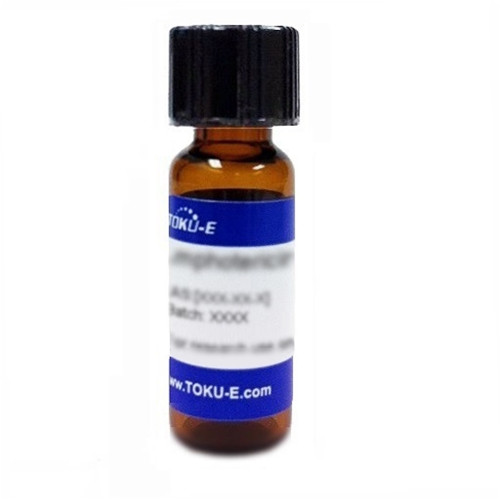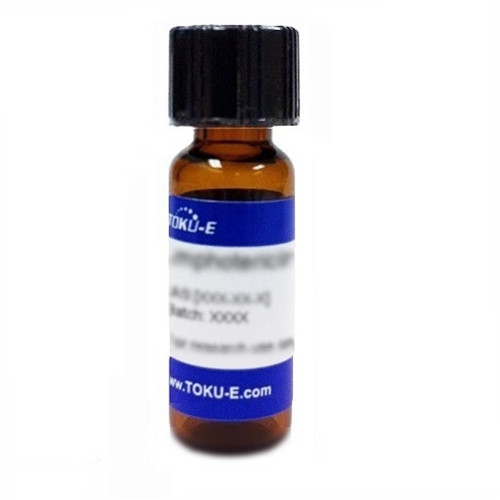Bacitracin A1, EvoPure is a highly purified form of Bacitracin fraction A1. The EvoPure line of Bacitracins are bioactive, non-toxic congeners that have not shown toxicity to cell lines in eukaryotic cell culture.
Bacitracin A1, EvoPure can be used to study properties and characteristics of Bacitracin A1 separately from other Bacitracin compounds found in standard grade bacitracin. Bacitracin A1, EvoPure can also be used as an analytical standard.
For all Bacitracin products, click here.
| Mechanism of Action | Bacitracin prevents phosphorylation of bactoprenol, a transport protein which carries peptidoglycan components outside the cell membrane. Without the active phosphorylated bactoprenol, peptidoglycan synthesis cannot be completed and the cell lyses. Resistance to Bacitracin is understood to involve two mechanisms: A protein transporter (BcrABC) which pumps bacitracin out of the cell after it has entered, and via another protein (BacA) which provides the active phosphorylated bactoprenol from a different synthetic pathway. |
| Spectrum | Bacitracin primarily targets the cell wall in members of the Gram-positive bacteria including Streptococcus pyogenes and Staphylococcus aureus. |
| Microbiology Applications | Bacitracin is a useful tool to differentiate between ß-hemolytic, group A Streptococci (Streptococcus pyogenes) and ß-hemolytic Streptocococci of other groups. Bacitracin can be used as a supplement in chocolate agar to facilitate the isolation of Haemophilus influenzae. Bacitracin can be used to study the regulatory network in B. subtilis. By systematically analyzing the Bacitracin stimulon, authors can pinpoint the loci induced by Bacitracin (Mascher et al 2003). |
| Plant Biology Applications | Tobacco hairy roots and cell suspensions were used in plant transformation studies to produce full length murine IgG1 monoclonal antibody. Bacitracin has been shown to prevent degradation of peptides and hormones in plant systems. Treatment with Bacitracin was not sufficient to prevent loss of antibody from the cultures, but improved the growth rates by up to 53%. (Sharp and Doran, 1999). |
| Eukaryotic Cell Culture Applications | Bacitracin can be used for gene selection in cell culture. TOKU-E tested the Selectivity Factor values for the different grades of Bacitracin, and found that range was 41- 350 CulturePure grade versus 2-126 for USP grade, for the cell lines tested (HEK293, NIH/3T3, 293T, CHO-k1, B16). Bacitracin A, EvoPure was used to study its effect on protein disulfide isomerase (PDI) inhibition (Webb et al, 2015)
|
| Molecular Formula |
C66H103N17O16S |
| References | Bell, RG (1992) Preparative high-performance liquid chromatographic separation and isolation of Bacitracin components and their relationship to microbiological activity. J. Chromatog. 590:163-68 Cain BD, Norton PG, Eubanks W, Nick HS and Allen CM (1993) Amplification of the bacA gene confers bacitracin resistance to Escherichia coli. J. Bacteriol. 175(12):3784-3789 PMID 8389741 Jacobsen C et al (2015) Regulation of tissue factor in NT2 germ cell tumor cells by cisplatin chemotherapy. Thromb Res. 136(3):673-681 PID 26205155 Langer F et al (2013) Rapid activation of monocyte tissue factor by antithymocyte globulin is dependent on complement and protein disulfide isomerase. Blood 121 (12):2324-2335 PMID 23315166 Mascher T, Margulis NG, Wang T, Ye RW, Helmann JD (2003) Cell wall stress responses in Bacillus subtilis: The regulatory network of the bacitracin stimulon. Mol. Microbiol 50(5):1591-1604 PMID 14651641 Mueller MJ, Brodschelm W (1993) Signaling in the elicitation process is mediated through the octadecanoid pathway leading to jasmonic acid. Proc. Natl. Acad. Sci. 90: 7490-7494 PMID 11607420 Sharp, JM and Doran, PM.(1999) Effect of bacitracin on growth and monoclonal antibody production by tobacco hairy roots and cell suspensions. Biotechnol. Bioprocess Eng. 4: 253 Stone KJ and Strominger JL (1971) Mechanism of action of bacitracin: Complexation with metal ion and C55-isoprenyl pyrophosphate. PNAS 68 (12): 3223-3227 PMID 4332017 Webb, NE “ Dose-response models reveal critical features of inhibitor activity and viral infection.” phD diss. UCLA, 2015 |







